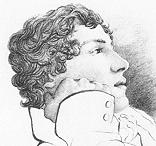The Odes by John Keats
Page 1 of 9 - 1 2 3 4 5 6 7 8 9 Purchase full notes for £4.95 (aprox $7.72)
Notes on The Odes by John Keats. This set of Tower Notes is 29 pages long and is sold as a fully illustrated PDF file.
To purchase, click on the link above and enter your payment details. You may purchase using Paypal or your credit/debit card. You do not have to provide your postal address if paying by Paypal, but an email address is required as a link will be sent automatically to your email account by return. Click on the link to download the PDF file. Please note that the link will expire after 48 hours. If you have any problems with your purchase, please do not hesitate to contact the webmaster at info@towernotes.co.uk
A free sample, text only, is provided below
Introduction: ‘of the Heart’s affections and the truth of Imagination’
All of Keats’ Odes are closely related and are best seen as a group. Their fundamental theme is the authenticity and supremacy of the imagination. Keats wrote to his friend Benjamin Bailey:
In fact, the other themes of these poems are built up about this cornerstone. Imagination, for example, provides an escape from suffering; indeed, at its deepest level, a means of transforming suffering . The speaker in the Odes frequently contemplates various means of escape from a painful existence, often dwelling on the idea of suicide. The imagination, or its product, beauty, is seen as an alternative to self-murder, and therefore a strategy for personal survival. However, “easeful Death” is sometimes powerfully seen as a climactic sensation: indeed the ultimate pleasure and the ultimate escape, as in this extract illustrates, taken from a letter Keats wrote in 1819 to his beloved Fanny Brawne:
To purchase, click on the link above and enter your payment details. You may purchase using Paypal or your credit/debit card. You do not have to provide your postal address if paying by Paypal, but an email address is required as a link will be sent automatically to your email account by return. Click on the link to download the PDF file. Please note that the link will expire after 48 hours. If you have any problems with your purchase, please do not hesitate to contact the webmaster at info@towernotes.co.uk
A free sample, text only, is provided below
Introduction: ‘of the Heart’s affections and the truth of Imagination’
All of Keats’ Odes are closely related and are best seen as a group. Their fundamental theme is the authenticity and supremacy of the imagination. Keats wrote to his friend Benjamin Bailey:
I am certain of nothing but of the holiness of the Heart’s affections and the truth of Imagination – What the imagination seizes as Beauty must be truth – whether it existed before or not – for I have the same Idea of all our Passions as of Love they are all in their sublime, creative of essential Beauty-
This passage (written November 22, 1817) serves as a valuable prospectus to the Odes. Love (“the Heart’s affections”) and imagination are closely linked here, as they are in Ode to Psyche . The “Passions” though, including love, are subordinate to imagination, but “in their sublime” (i.e. taken to the furthest extent of delight) they feed the creative power (imagination) enabling it to produce “essential Beauty.” For Keats, the highest truth, therefore, is a matter of sensation not thought, hence, “What the imagination seizes as Beauty must be truth.” Further comments from the letter to Bailey are enlightening in this respect:The imagination may be compared to Adam’s dream (of the creation of Eve, Paradise Lost VIII, 452-90) – he awoke and found it truth. I am the more zealous in this affair, because I have never yet been able to perceive how any thing can be known for truth by consequitive reasoning...O for a Life of Sensations rather than of Thoughts!
In essence, Keats believed that sensations, passions and love, when ‘wrought to their uttermost’ fire the imagination into the creation of beauty, which is the truth of the artist. Thought, on the other hand, only leads to reasoned argument and the truth of the philosopher. One of the key themes of the Odes, therefore, is the imagination itself and imaginative truth.In fact, the other themes of these poems are built up about this cornerstone. Imagination, for example, provides an escape from suffering; indeed, at its deepest level, a means of transforming suffering . The speaker in the Odes frequently contemplates various means of escape from a painful existence, often dwelling on the idea of suicide. The imagination, or its product, beauty, is seen as an alternative to self-murder, and therefore a strategy for personal survival. However, “easeful Death” is sometimes powerfully seen as a climactic sensation: indeed the ultimate pleasure and the ultimate escape, as in this extract illustrates, taken from a letter Keats wrote in 1819 to his beloved Fanny Brawne:

